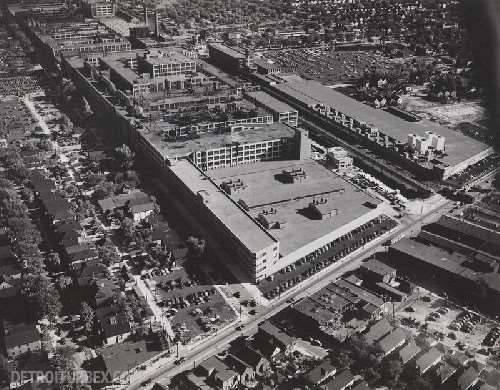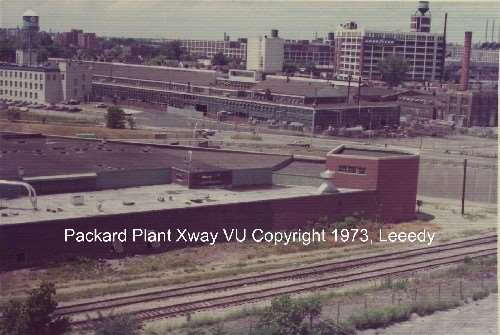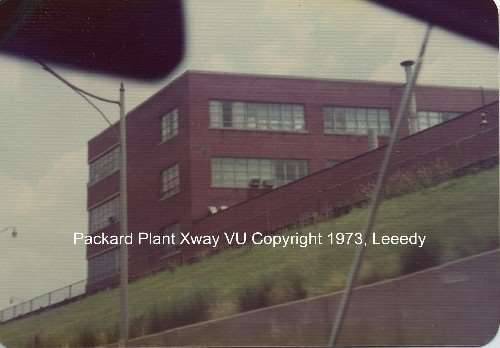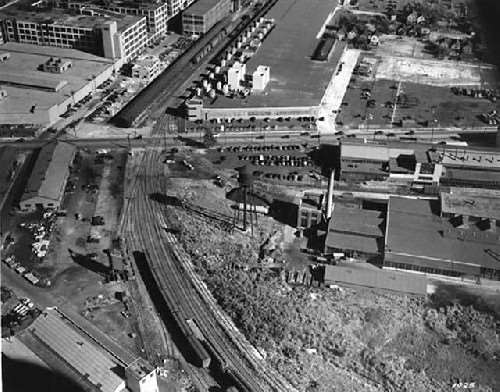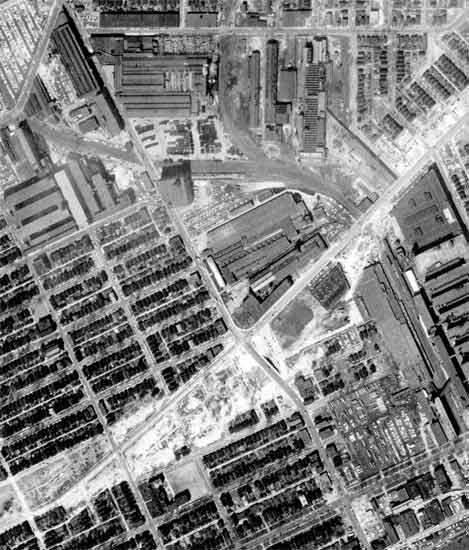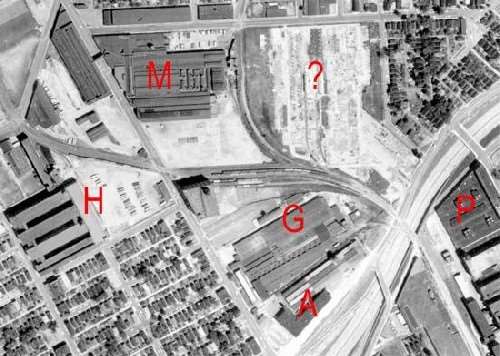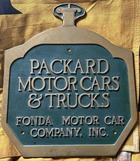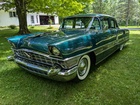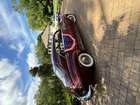|
Re: One Story Assembly Plant What If?
|
||||
|---|---|---|---|---|
|
Home away from home

|
I have never heard of Cadillac using PPG and think you have switched some facts around in your head since reading them.
That's certainly possible. Seems that I read somewhere that Caddie used the track in 37-38, but maybe the person that wrote what I read had it wrong.
Posted on: 2014/5/15 18:46
|
|||
|
||||
|
Re: One Story Assembly Plant What If?
|
||||
|---|---|---|---|---|
|
Home away from home

|
Hello Steve203
Back on page 3, post #21, you said: "Take a look at the old proving grounds from the air. With Google satellite view, use 50500 Mound Rd as an address. There was no security. The north and south ends of the oval were only a few feet from public roads. Anyone could stand on public land and see what was going on in the track." Ummm...no. It is one thing to look at a current Google Earth satellite view and quite another thing to actually drive by the PPG when it was in use. You could NOT see the track from either 22 Mile Road or 23 Mile Road. This is because of the 25 foot to 30 foot high earth berms for the high-speed, BANKED turns, not to mention the trees and other foliage at the top of the bank/berm. When the track was removed a few years ago the berms were then graded to be at nearly the same height as the road and you can now see the vacant infield of the former track. BTW, the actual address of the PPG is 49965 Van Dyke. We are having a car show (Cars-R-Stars @ the PPG) on Sunday, June 8th. I will be working the Main Gate all day long. Come on out and introduce yourself. Finally, we have zero records regarding Cadillac leasing the PPG, Chrysler: yes, during the war years. Cadillac; no. I also have a copy of a report from AMC was preparing to buy the PPG at back in the 1960s as they were tired of going to Kenosha for their testing. --Roger--
Posted on: 2014/5/15 18:55
|
|||
|
||||
|
Re: One Story Assembly Plant What If?
|
||||
|---|---|---|---|---|
|
Home away from home

|
<i>BTW, the actual address of the PPG is 49965 Van Dyke. We are having a car show (Cars-R-Stars @ the PPG) on Sunday, June 8th. I will be working the Main Gate all day long. Come on out and introduce yourself.</i>
Thanks. I used the 50500 Mound address as that is what I found when I was trying to locate the plant some time ago. The Gilmore has a vintage motorcycle show on the 8th, but I'm not that in to bikes. <i>Finally, we have zero records regarding Cadillac leasing the PPG, Chrysler: yes, during the war years. Cadillac; no.</i> The other account of the test track history I read was obviously in error. Thanks everyone for the correction. <i>I also have a copy of a report from AMC was preparing to buy the PPG at back in the 1960s as they were tired of going to Kenosha for their testing.</i> Some of the AMC styling guys show up at the AMC meet in Livonia each year. They all worked in the Plymouth Rd offices. I never asked them how they liked the trip to Wisconsin, but I imagine it was even less fun in the 50s when there were no freeways. Apparently they were not too worried about Ford people spying on them from the plant. The AMC track was bought by MGA Research in 88 and still exists, and still way out in the boonies outside of Kenosha. 5000 Warren Road, Burlington, Wisconsin
Posted on: 2014/5/15 20:22
|
|||
|
||||
|
Re: One Story Assembly Plant What If?
|
||||
|---|---|---|---|---|
|
Home away from home

|
On pages 205 and 209 of Automobile Quarterly's "Buick - A Complete History" by Dunham and Gustin (published 1980) are three photographs showing a 1938 and a 1939 Buick being tested at the PPG. Buick even rented the Packard "Towing Dynamometer". Copyright issues prevent me from posting the photos.
Posted on: 2014/5/15 22:16
|
|||
|
||||
|
Re: One Story Assembly Plant What If?
|
||||
|---|---|---|---|---|
|
Home away from home

|
Quote:
It is amazing, stunning that people are continuing to claim that the Packard plant had no rail access. This is simply just not true and I have been all over this topic in the posting section on this web site entitled "How did they do it?" Packard had tons of rail access. I was there. I saw it. Regularly. People are making all kinds of mistaken conclusions today off of bad photos and 21st century satellite views that leave off the reality of what things really looked like when Packard was in business! You may not be seeing it in photos and Google maps today, but it was certainly very much there! Rail heads came out of what was a huge shipping and storage lot at Mt. Elliot and East Grand Blvd. This had all been torn out by the 1960s, but sorry, it WAS indeed there when the plant was operating. There was a second line of track and spurs that went right through the plant and supplied coal to the power plant, oil, gasoline and lube to the plant depot and more. MORE rail access. It is neither fair, nor accurate to say that all this did not exist because it did! Most of this was removed in the ensuing years, but it certainly was there. RE: Conner Ave. Packard Plant being "single story"... Again, this is not true. There was indeed a second floor there and the first floor height was already huge. There were in fact overhead conveyors that indeed led to the second floor (as well as stairs) and you can see all of these things in plant layouts. And it is likewise amazing that people have somehow forgotten the total fascination in the 1950s with single-story facilities of all kinds... from schools to factories. Stacked floors, stairs and elevators were considered outmoded and old-fashioned in the 1950s. Every-and I mean every write-up about the Conner Avenue Packard Plant referred to it as "modern" and implied it was cutting edge in every way. Now, all these years later we have folks railing against single-story factories! RE: Packard Plant being "surrounded by urban residential"... (Presumably this means the Packard Plant on East Grand Blvd.) A good number of the people living in those "urban residential" areas in fact worked at the plant. And all of these areas came AFTER the plant, not before it. Furthermore, Conner had loads of residential area around it-which is why it was almost immediately turned into a shopping mall after Packard left! In fact, one of the most controversial government housing projects ever in Detroit was right across the street! I won't go into this one, but there were lots and lots of "urban residents" in the area... probably a lot more than over at Grand Blvd. Gotta know your Detroit history here. RE: buying Willow Run instead of Conner Briggs...Doing so would have been twice or even three times as expensive as doing Conner-if only from an operational standpoint. That would have been like going out of the world backwards. And Willow Run wayyyyy the heck out out by Ypsilanti in those days to a Detroiter was considered a HUGE trip... it was nowhere near Detroit city limits-no matter what direction it was on the compass. With Conner, the movement of cars by truck continued almost as it had earlier since the cars were still stored and shipped out from the same place as always at Mt. Elliot and East Grand Blvd. And the bodies had already been coming from Connor anyway. Had Packard moved to Willow run, this storing/shipping operation would have been lost too... or absurdly expensive to continue using. People today think nothing of going to Ypsi from Detroit. I have a cousin who lives there. But...this was a very, very long trip from Detroit (especially East Grand) out there in those days. And the highways were nothing like today when a drive to Ypsi is nothing. Again, gotta adjust your thinking from 21st century back to the 20th century and the 1950s. Furthermore, Packard bodies were already being built at Conner anyway! All Packard did was move the rest of the assembly line from Grand Blvd. to Conner to finish the complete car rather than truck the bodies from Conner over to East Grand. They didn't have to pick up every last thing and drag it over to Conner. So all of the howling about Conner is not about a complete move of anything. Yes, Conner could have been bigger. Yes, the move could have been a better one. Yes, the changeover could have been better refined. Much new equipment was added at the time and there were many unproven machines and processes that needed to have the bugs worked out. There just wasn't time to do all this. Then factor in the new V8 engine, new technology torsion suspension, new body styling... all these things were happening at the same time! It is a miracle that it worked out as well as it did with so many opportunities for something to go wrong! So people today need to put this all into perspective. RE: James Nance wanting to run Packard into the ground"... While this may be the opinion of those stalwarts (some of them good friends) who saw his moves as too brash, too naive, too radical or too expensive, the man did what he thought was best. But it was just too much, too late. Like the guy who yanked the helm on the Titanic hard to one side, there was no way that ship was not going to hit the iceburg. So if we want to do the blame-game here it was Curtiss-Wright that put the final nail in the coffin- no matter how many people were sticking pins in their Jim Nance dolls. Anyone who even remotely believes the fantasy that Jim Nance did NOT want Packard to succeed is simply mistaken. And obviously never talked with him. I can assure you, losing Packard broke Nance's heart and he was still hurting about it many years later-even if he rarely showed it. Of this, I can assure you... straight from the man.
Posted on: 2014/5/16 14:32
|
|||
|
||||
|
Re: One Story Assembly Plant What If?
|
||||
|---|---|---|---|---|
|
Home away from home

|
Quote:
The photo displayed in this posting is looking southward, but there is no "freeway" shown (we called them "expressways" back then in Detroit) because this photo was taken long prior to the building of the expressway (freeway). The term, "freeway" by the way was borrowed and adopted later from Los Angeles. Detroit actually changed all of the names from "Expressway" to "Freeway"...heaven knows why. But they were originally called expressways. There is a famous photo of a late 1940s all over the internet with a Packard next to a sign that says "To Detroit via Expressway"... Anyway, when the Edsel Ford Expressway was built it went right down Harper Avenue at this point, this Harper ceased to exist here. When the expressway was built, a concrete retaining wall was poured in at the very edge of Harper and all that was left of the long rectangular parking lot where you see cars sitting (blacktop lower center of the photo along the building) was a narrow access road. The expressway took every inch of land it could get. At one time prior to this, the Packard Plant property (and a small test track) extended north (lower right) of where Harper Avenue is in this photo. New car storage/shipping was off in the huge lot on the upper right of this photo-even after the Conner plant was put in operation. I am attaching two photos I took in 1973. One shows a view looking northward toward the Ford Expressway and what was left of Harper Avenue. I took this from the rooftop of the Packard Plant where I had access to go at the time. You can see two tracks were left at this time and you can see the bed where another was removed. If you look past the concrete ditch of a freeway (cars are down below) you can see Chrysler's Oilite Bearing facility, Good Year Tire & Rubber, and Mt. Elliot heading north toward Rinshed-Mason. Most of this stuff is gone now. At the time of this photo the north end of Packard along the expressway was occupied by Stone Container Corporation and Essex Wire Corporation. The other shot I took was while down below on the Edself Ford Expressway looking up at the concrete retaining wall and north end of the Packard plant as seen from the freeway. This is all you could see from the expressway because is is down in a narrow concrete ditch. In the B&W photo shown earlier in the post, I would be driving 30 feet below the surface of what was then Harper Avenue. Today this building is at Concord Avenue and the Edsel Ford Freeway. It is the end of same building you see in the lower end of the B&W photo in this posting. Also, today, all of the windows have sadly been bricked in. Probably why it has not been vandalized any worse than it has...
Posted on: 2014/5/16 15:04
|
|||
|
||||
|
Re: One Story Assembly Plant What If?
|
||||
|---|---|---|---|---|
|
Home away from home

|
<i>Packard had tons of rail access. I was there. I saw it.</i>
Here's a photo of the north side supposedly taken in 42. Gives a good look at the spur as it comes south from the foundry, across Harper and through the factory complex. That spur heads north and into the huge rail yard that is still between Mt Elliot and Conant.
Posted on: 2014/5/16 16:24
|
|||
|
||||
|
Re: One Story Assembly Plant What If?
|
||||
|---|---|---|---|---|
|
Home away from home

|
<i>RE: Packard Plant being "surrounded by urban residential"...</i>
One thing I noticed in the film about Packard's war work, as the flim is highlighting the new construction for the Merlin program, they superimpose a plant in the middle of the Lutheran cemetary. That plant was in Toledo, at 1330 W Laskey. After the war, Packard did some jet engine work there, until the development program was terminated in 49. That plant, which was government owned, was vacant until Continental moved in in 55. <i>And Willow Run wayyyyy the heck out out by Ypsilanti in those days to a Detroiter was considered a HUGE trip...</i> The freeway to Willow Run was one of the first constructed in Michigan. A section from the bomber plant east to Huron River Dr was built in 42. In 44, the "Detroit Indistrial Expressway" extended it to Southfield. In 45, the freeway was complete to Michigan Ave at the Dearborn/Detroit border. By the time frame we are talking about, 53, the freeway had been extended to Grand River. In 54 it reached the Lodge. In 55 it was completed to Russell St and it reached Mt Elliott in 57. It reached Conner in 58. Getting people and goods to Willow Run from downtown Detroit in the mid 50s was a snap compared to getting to/from what became the powertrain plant in Utica. As for the economics of Willow Run vs Conner, even after the line at Conner had been debottlenecked, who knows, really. I have seen numbers that Packard figured they would save $3M by going into Conner, but it cost them an extra $3M instead.
Posted on: 2014/5/16 16:54
|
|||
|
||||
|
Re: One Story Assembly Plant What If?
|
||||
|---|---|---|---|---|
|
Home away from home

|
<i>Anyway, when the Edsel Ford Expressway was built it went right down Harper Avenue at this point, this Harper ceased to exist here. When the expressway was built, a concrete retaining wall was poured in at the very edge of Harper and all that was left of the long rectangular parking lot where you see cars sitting </i>
Here's a pic from 56 showing the right of way being cleared for the freeway. Compared to the 1942 pic, you can see how the north wall of the Merlin test/inspection building has been cut back a good 100' to make room for the right of way. The west wing of the building, where the Merlin test cells were is about to be demoed. What I find odd is that, after the north wall of the inspection building was cut back, the little two story office space in the northeast corner of the building was rebuilt. The 1961 photo shows it, and you can tell it's new construction because the color of the roof is diffenent. btw, that is one awesome Caribbean. 55? That isn't the Jean Peters Caribbean is it? That black/white/pink combination seems to have been popular, but that was the color her's was.
Posted on: 2014/5/16 17:10
|
|||
|
||||

 (111.35 KB)
(111.35 KB)